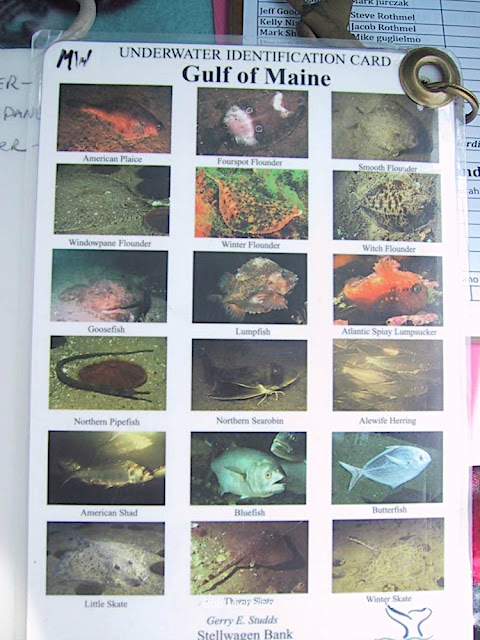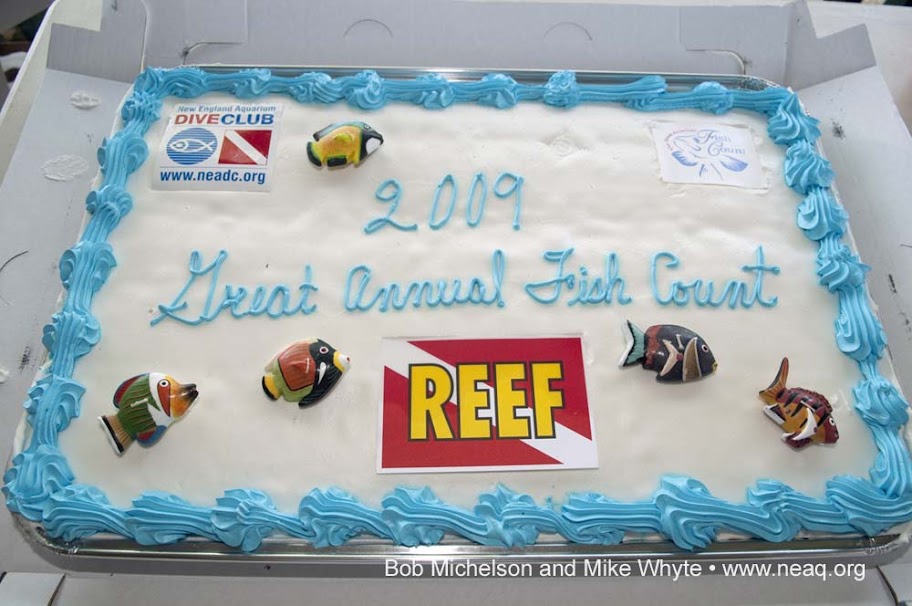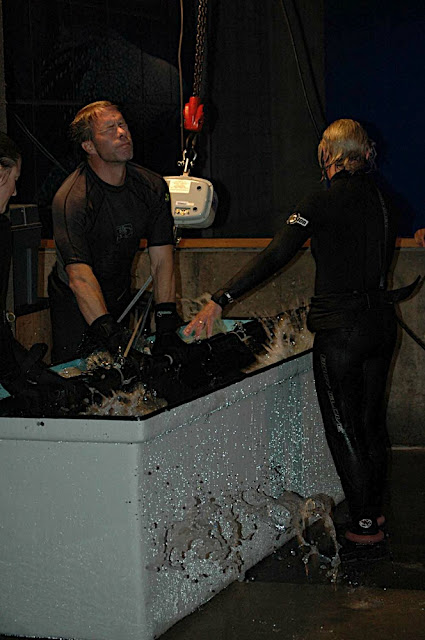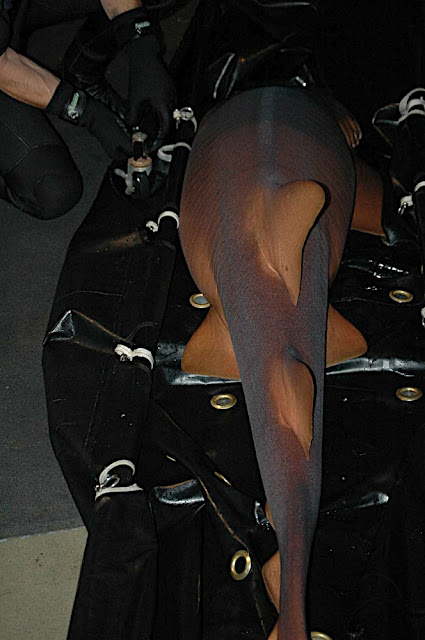When I'm not feeding the more than 600 animals that call the
New England Aquarium's Giant Ocean Tank (GOT) their home, I'm fascinated watching animal behaviors that are always going on. While I love diving in the GOT on a regular basis, I got my start diving in the cool New England waters where I watched these same animal behaviors for the last 25 years.
These observations came in handy as the
New England Aquarium Dive Club (NEADC) and the
Reef Environmental and Educational Foundation (REEF) sponsored the 8th annual Northeast Great Annual Fish Count held up on Cape Ann, Massachusetts. This year, there were 119 divers who submitted 140 surveys and identified 45 different species! All three numbers were records for the eight year old event, which is the largest of it's kind in the country. These divers observed 4 or 5 species that were never observed before, like the
Atlantic wolf fish and the
Atlantic torpedo ray. So, what did we see and how did we count them? Using underwater slates with waterproof paper, as well as laminated fish ID pictures, we marked down only fish that we could positively identify. They were categorized using "single" for one fish, "few" for 2-10 fish, "many" for 10-100, and "abundant" for over 100.


After the dives, these observations were transferred to survey sheets back at the staging area and submitted. Then came the fun part! This year there were over $8500.00 dollars in prizes including a dive vacation, wetsuits, regulators, fins, masks and a rare opportunity to dive into the GOT here at the New England Aquarium, which is always one of the most sought after prizes!

There was quite a spread of food supplied by the New England Aquarium Dive Club afterward. This year the weather has been very wet but we had a beautiful day for the event. Underwater visibility wasn't the best due to all the rain we've had recently but that's New England diving. This year, there was participation from 7 or 8 different local dive clubs. While the prizes were great incentive, this also gives divers the opportunity to become "citizen scientists" and contribute to helping to address a variety of questions on marine life populations and species to marine scientists. Those of you who are divers, consider joining REEF and
fill out a survey form for every dive you do. It's up to all of us to help protect our blue planet.

Be sure to check out the
NEADC's Annual Tropical Fish Rescue coming up in September. Tropical fish in New England? Every fall, juvenile tropical fish travel up north in the Gulf stream and end up in the shallow waters in southern New England. As the fall weather begins to cool. so do the ocean temperatures and the tropicals can't handle the cooler temps, so NEADC collects these animals and some have even been introduced into the GOT!
So, don't forget to check out the GOT blog for details on what we found and rescued. It's the thrill of the hunt!
-
Mike
 subscribe
subscribe


 Staff and volunteers arrived at 6:00 a.m. to begin the preparation process. Shark exams require an enormous amount of planning as well as a lot of highly specialized equipment.
Staff and volunteers arrived at 6:00 a.m. to begin the preparation process. Shark exams require an enormous amount of planning as well as a lot of highly specialized equipment. Divers prepare for step one; the injectable anesthesia.
Divers prepare for step one; the injectable anesthesia. Waiting for the right moment....
Waiting for the right moment.... Got it!
Got it! Once the injectable anesthesia has taken effect (shark is a bit groggy), divers use a wand attached to a spray bottle full of liquid anesthesia to further anesthetize the animal. The liquid anesthesia has a sleep like effect, much like anesthesia that is used on humans. Additional divers use long poles with tennis balls on the ends to help direct the shark towards the wand.
Once the injectable anesthesia has taken effect (shark is a bit groggy), divers use a wand attached to a spray bottle full of liquid anesthesia to further anesthetize the animal. The liquid anesthesia has a sleep like effect, much like anesthesia that is used on humans. Additional divers use long poles with tennis balls on the ends to help direct the shark towards the wand. Once it is determined that the shark is drowsy enough to handle, divers use the poles to gently guide him into the stretcher.
Once it is determined that the shark is drowsy enough to handle, divers use the poles to gently guide him into the stretcher. Once the shark is secure in the stretcher, divers bring him to the surface.
Once the shark is secure in the stretcher, divers bring him to the surface. The stretcher is then lifted out of the water using an electronic hoist
The stretcher is then lifted out of the water using an electronic hoist Staff carefully lower the shark into a fiberglass box especially designed for shark exams.
Staff carefully lower the shark into a fiberglass box especially designed for shark exams. Bimini was a bit light on anesthesia, and made quite a fuss when placed in the exam box. She eventually settled down nicely.
Bimini was a bit light on anesthesia, and made quite a fuss when placed in the exam box. She eventually settled down nicely. A hose within a PVC tube that is attached to a pump is placed in the shark's mouth. This ensures a constant flow of water; important for respiration.
A hose within a PVC tube that is attached to a pump is placed in the shark's mouth. This ensures a constant flow of water; important for respiration. The veterinarians now prepare for the medical examination.
The veterinarians now prepare for the medical examination. The shark is measured and a blood sample is taken.
The shark is measured and a blood sample is taken. The most challenging part of the exam is radiographs. The shark has to be taken out of the water and placed on the radiograph plate. When not breathing the anesthetized water, the shark can wake up, so this has to be done very quickly.
The most challenging part of the exam is radiographs. The shark has to be taken out of the water and placed on the radiograph plate. When not breathing the anesthetized water, the shark can wake up, so this has to be done very quickly. Once the exam is completed, the shark is returned to the exhibit in much the same way that he/she was removed. They are brought to the bottom in a stretcher, and observed closely by the dive staff until they are up and swimming.
Once the exam is completed, the shark is returned to the exhibit in much the same way that he/she was removed. They are brought to the bottom in a stretcher, and observed closely by the dive staff until they are up and swimming.







